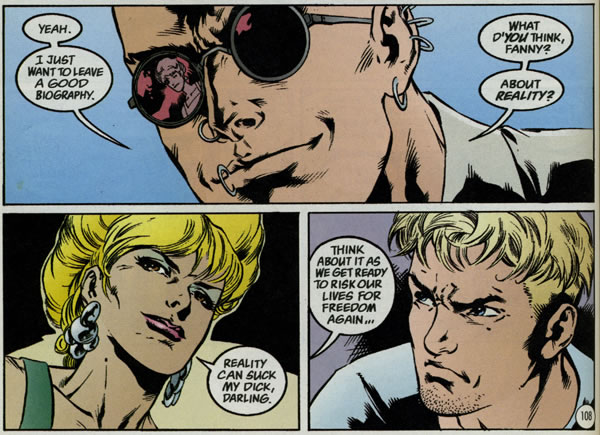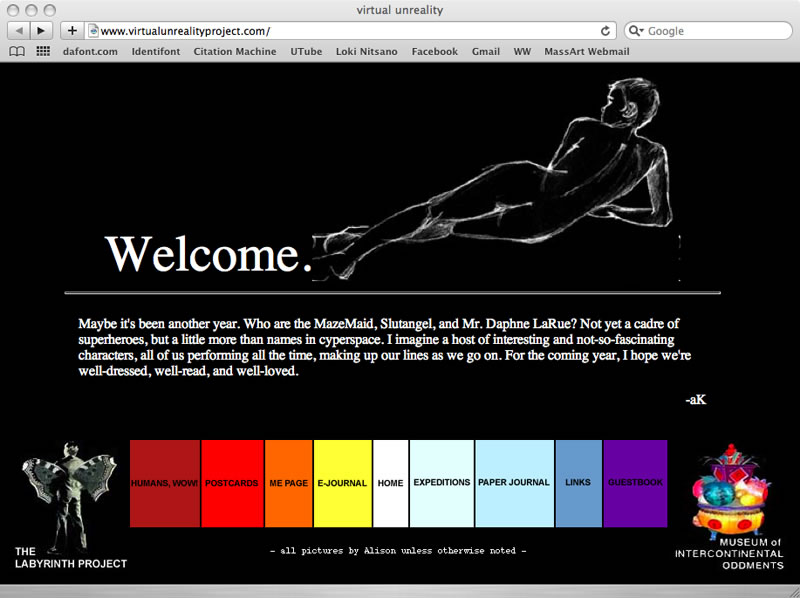By Alison Kotin, MFA ’11
essay
Abstract:
An exploration of my/ own autobiography as told through interactions with dynamic media. The dynamic media user constructs a digital persona whose desires influence the experience of media interaction. To the extent that the creation of this persona is an intentional and performative act, potential exists for an “aesthetic” experience as defined by John Dewey.
Beginning
In 1998, on the precipice of the 2000’s dot-com collapse, I was an English major at Brown studying language and gender in contemporary fiction. I struggled to come to terms with my own sexual identity and place within or outside communities defined by sexual orientation, postmodernist theoretical affiliation, and college campus social patterns. At the height of my ambivalence over personal identity and academic affiliation, I became fascinated with the possibilities web design and “hypertext narrative” offered for a reinvention of the self. Close reading of Judith Butler’s Bodies That Matter and Gender Trouble along with Roland Barthes’ writing on language and pleasure provided me with a theoretical framework to question the solidity of language and narrative structure, and by inference to consider the conundrum of whether the words we use could in fact shape our perceptions of the world (Butler, 1990).
Coming out as gay in college led me through an extensive personal and academic quest for identity and a stable sense of my place in the world. Shying away from labels and the political weight attached to self-identification with one identity or another, I was drawn to the linguistic ambiguity of postmodernist theorists’ and novelists’ writing. Cyberpunk stories from Caitlin Sullivan and Kate Bornstein’s Nearly Roadkill and Grant Morrison’s Invisibles series to Neal Stephenson’s Snow Crash and Samuel Delany’s 1984 Stars In My Pocket Like Grains of Sand together created a picture of an alternate reality populated by nonchalant rebels whose every expression of self or identity was an act of performance. Identifying myself with characters like Nearly Roadkill‘s Winc or The Invisibles’ Lord Fanny, I aligned my creative practice with people who consciously molded and created futuristic digital identities as artistic and performative works. Although fictional, these characters’ experience of fleeing a physical world they found overly restrictive in favor of an unlimited, ever-changing cyber identity offered me a model for melding my own academic and artistic exploration with my evolving sense of self.
Experience
As described by John Dewey, “an experience” can be identified as an individual’s progression from initial engagement with a series of events through “fulfillment” or closure. When events have run their course, an experience (as opposed to a series of episodes without long-term consequence) is identified as a story arc with beginning, middle episodes, and an endpoint that provides the basis for a retrospective summing-up. “Doing” and “undergoing” are paired in Dewey’s model, meaning that a true experience cannot emerge from either passive receptivity or thoughtless action without reflection. Emotion, the “moving and cementing force” of an experience, knits episodes together into a coherent sequence, making sense of conflict, growth, and progression of ideas and relationships (Dewey, 1934).
The “aesthetic experience” Dewey describes goes beyond the traditional “doing” and “undergoing” of other experiences to encompass a key element of “making.” In creating a new work, an artist participates in his or her own experience as thoughts and concepts are translated through an artistic or performative medium. Ongoing awareness of a potential audience and a desire to facilitate their experience through a work of art sets the act of aesthetic creation apart (Dewey, 1934). A creator who produces an “external embodiment” of his or her own experience enters into a relationship with the audience or receptors of the finished piece, engaging with emotion, conflict, and growth to transmit a story or idea. The experience of the self-aware artist goes beyond the act of creation to encompass a dynamic, shifting relationship with an idealized or imagined other, who will in turn experience the finished artistic work and form his or her own story arc of creation and engagement.
Middle
I began to learn HTML near the end of college, saturated with literary theory and dizzy with excitement over the simultaneously personal and political significance of reinventing my identity to my own specifications. In a writing seminar I learned the Storyspace software, a program created in the 1980’s to simplify the process of authoring interactive “hypertext narratives.” Rather than the linear structure of a written page (or even the vertical “stacks” of Hypercard), Storyspace is designed to facilitate the creation of densely woven, web like structures with nodes of content connected by links (Eastgate Systems, 2007). The underlying assumption of the Storyspace interface is that any work authored will reject traditional linearity in favor of data interconnected by relationships too complex to hold simultaneously in mind. This assumption, both liberating and intimidating (examples of similar narratives included canonical works from Jorge Luis Borghes’ Garden of Forking Paths to Umberto Eco’s The Name of the Rose) led me to question the essential components of a story, recombining photographs, poetry, maps, and sound files into hybrid works.
Working with Storyspace, a simple interface to HTML coding, I had the experience of finding that the media with which I interacted became a transparent window into a new, non-corporeal space. The branching narrative structures that Storyspace made visible encouraged me to see web-based writing as a space that an imagined body could enter and explore. As I became more adept with HTML and digital storytelling, the web became a space that I imagined could be navigated and constructed as well as interpreted and conceptualized. I created elaborate personal websites, casting myself in the role of a mysterious, ambiguously gendered emcee in ever-evolving galleries of curiosities ranging from the literary to the zoological. The online format allowed me to combine my writing with other kinds of artistic creation, taking me first unconsciously, then with greater intention, down a path of artistic study that eventually led to my current design career.
In experimenting with the creation of new identities and personae, I became conscious for the first time of an audience for whom I could create an experience. I imagined that the invisible audience of fellow web travelers interacting with my digital persona could be vast (although in reality it was likely modest). The unseen presence of visitors and users of my work led me to consider the impact of my words and images on strangers. The performative aspects of my roles took on greater significance, as did the possibility that visitors to my online spaces would not distinguish between my imagined virtual identities and the “real me.” In creating an experience for users of my work, I was in some way altering reality, making myself in the eyes of others into many alternate selves. I was engaging in what Dewey terms an “aesthetic experience of making,” channeling my own experiential narrative into artistic works that in turn created an experience for their viewers (Dewey, 1934).
My 1999 engagement with dynamic media was relatively unfiltered. I initially learned HTML and Storyspace and designed spaces for my online selves by laboriously typing tags in Simpletext, then uploading images and HTML pages via modem. The online world I inhabited had no guidelines for how to proceed, and conversely, very little support to make the design and updating process user-friendly. This meant that while technically my work was based on hit-or-miss experimentation, I was able to create narrative, image galleries, and virtual spaces without any significant influence from my online hosts. I was empowered by Storyspace and fictional cyberpunk heroes to conceive of the online realm as a world where I could build, dismantle, reconfigure, and discard puzzle-pieces of my creations that ranged from a virtual museum wing, to a labyrinth, to a visual autobiography, to a poetry anthology.
Experience and Dynamic Media
A central characteristic of a “dynamic media” experience is users’ ability to engage with media objects that in turn adapt to, change, and interact with their audience over the course of a sustained interaction. The possibility of choice, reconfiguration, customization, and personalization inherent in the dynamic media interface, and the necessary variability of dynamic media objects when in use by multiple individuals, require the user to take an active role in the creation of his or her own experience (Manovich, 2001).
Can the long-term, variable, and customizable interaction between a user and a dynamic media object result in an experience that follows Dewey’s required narrative arc of engagement and resolution? When “an experience” is defined as a series of episodes joined by emotion into a narrative arc, the dynamic media objects that seem most likely to provide that experience are those which facilitate a user’s own process of creation. By providing an interface to extensive information resources, customizable to individual users’ specific interests and preferences, dynamic media can fuse Dewey’s concepts of “doing” and “undergoing.” The dynamic media user makes meaning from assembled but perhaps disparate informational resources, and simultaneously constructs a digital persona whose desires influence the experience of media interaction. To the extent that the creation of this persona is an intentional and performative act, potential exists for an “aesthetic” experience as defined by Dewey (Dewey, 1934; Manovich, 2001).
Dynamic media tools from HTML editors to social networking sites facilitate both the creation and continual modification of self-image and public personae online. At the same time, customized marketing campaigns are targeted to individuals, rewarding those who portray a coherent consumerist persona with offers and incentives tailored specifically to their preferences (Manovich, 2001). Online communities such as Facebook or Livejournal provide an easily accessible forum for self-expression whose visual qualities (appearance, composition, information hierarchy, etc.) are rigidly controlled by site administrators. These online communities also provide a conduit for personalized advertising to individual users. A webhost for a personal site provides access to a blank canvas for online self-expression without restrictions on content or aesthetic form, but requires a far higher level of technical skill and creative engagement from creators. In this way dynamic media, and specifically online interfaces for the creation of digital personae, encourage users to take on “the responsibility to represent the world and the human condition in it” while limiting to a greater or lesser extent an individual users’ ability to aesthetically express an unfiltered point of view (Manovich, 2001).
Resolution/ Continuation
My entry into online performance and artistic creation was a liberating and empowering experience. In 1999 I felt that my online experimentation with self-identity and persona was part of a larger movement of questioning the unacknowledged power structures of society. On a deeper emotional level, I felt that I had been given the chance to invent myself in the image of who I wished I were, with full acknowledgement that that persona could remain in a state of constant flux.
Through many iterations of personal websites and non-linear, web-based storytelling I began to see myself as an artist whose goals extended beyond self-discovery to the creation of new experiences for an anticipated audience. As my awareness of audience (and my technical skills) increased, I also gained self-confidence in the identity of “creator,” an appellation flexible enough to contain the many contradictory parts of myself. This mental evolution let me separate myself from my work enough to allow for the “aesthetic experience” of artistic creation Dewey describes: “to build up an experience that is coherent in perception while moving with constant change in its development” (Dewey, 1934). Rather than identifying my cyber-self with fictional characters, I could draw parallels between my real self and the authors whose works I read.
The experience of creating my digital personae, facilitated through HTML and Storyspace, took place over the course of several years. In retrospect, this was a time of rapid personal growth as well as technological evolution, a path of skill development and self-reflection that connects my current design practice and identity to my self of 12 years ago.
Experience and Mythology
Considered in hindsight, my first web design projects and creations of alternate digital personae constitute a central experience in the larger narrative of my path to adulthood. From the present day, I am able to look back on the events of 10-12 years ago and reconstruct from them a reasonably straightforward narrative that adheres to the storytelling conventions Dewey outlines in describing “an experience.” Although these episodes have become an important part of the longer narrative of my own autobiography, it is unlikely that I have been able to reproduce them here with perfect accuracy or clarity. As with the “experience” Dewey describes, my engagement with digital performance and online spaces has gained a symbolic quality to become an “enduring memorial” that provides a point of reference for my memories of that time of my life (Dewey, 1934).
According to historians and anthropologists, storytelling and personal mythmaking stem from human impulses that are as old as the species. Stories are an accessible format to organize important information, they give meaning to otherwise random events by providing the emotional connections that bind episodes together, and they provide us with a pattern by which to make sense of the events of our lives (McAdams, 1997). The “enduring memorials” Dewey describes stand out from less significant happenings, and act in retrospect as signposts to help us find our way back through the stories of our own past history. In the words of philosopher Paul Ricoeur, “time becomes human time to the extent it is organized after the manner of narrative” (McAdams, 1997). From this perspective, a cohesive narrative that makes sense of experiences and shows their place in the protagonist’s larger life story may take precedence over accurate recall of details. In other words, we may need to build memories of “experiences” as defined by Dewey to help us come to terms with the events of our lives, which in turn form the “personal mythology” that sums up our conception of ourselves (McAdams, 1997).
Interaction with dynamic media objects has the potential to create the kind of experience Dewey seeks in engagement with other, more traditional artistic creations. In fact, successful dynamic media objects or interfaces encourage engagement over the long term, changing or reacting to input as a user’s desires and interests evolve (Manovich, 2001). This interactive ability alone does not guarantee that the experience will become an “enduring memorial” in the memory of a user: Dewey’s balance of “doing and undergoing” must still be present. In my personal experience, the dynamic media interactions that have taken a significant place in my autobiographical mythos are those that supported my own self-discovery and personal expression. My experience comes from dynamic media objects that helped me to understand and explore something about myself not previously acknowledged or expressed.
Works Cited
Butler, Judith. Gender Trouble: Feminism and the Subversion of Identity. London: Routledge, 1990.
Dewey, John. Art As Experience. London: Penguin Books Ltd., 1934.
Manovich, Lev. The Language of New Media. Cambridge, MA: The MIT Press, 2001.
McAdams, DP. The stories we live by: personal myths and the making of the self. New York: The Guilford Press, 1997
Morrison, Grant, Chris Weston, and Ivan Reis. The Invisibles: Kissing Mister Quimper. New York: DC Comics, 2000.
“Storyspace.” Storyspace. Eastgate Systems, 2007. Web. 14 Nov 2009. http://www.eastgate.com/storyspace/
Sullivan, Caitlin, and Kate Bornstein. Nearly Roadkill: an Infobahn Erotic Adventure. London: High Risk Books/ Serpent’s Tail, 1996.
Editor’s note: Students were asked to examine a dynamic media object in light of John Dewey’s definition of “an experience” which he defines in Art as Experience, Chapter Three: Having an Experience.





